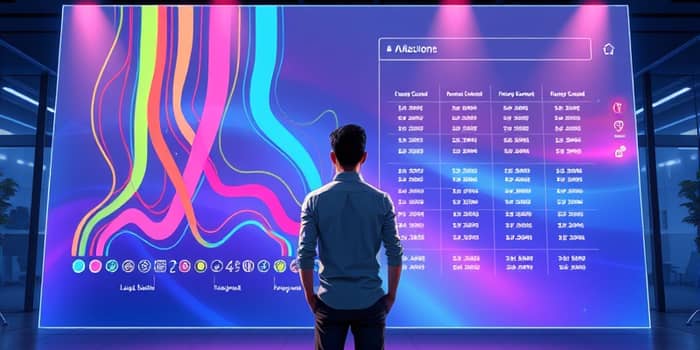In an age where every dollar seems to vanish into thin air, understanding exactly where your money goes can feel like chasing shadows. Thanks to rapid advances in financial technology, or fintech, users now have unprecedented tools at their fingertips to uncover spending patterns, optimize budgets, and achieve long-term goals. In this article, we explore how innovative platforms are transforming abstract numbers into gain real-time spending insights and empowering individuals to take full control of their finances.
Understanding Fintech and Its Growth
Fintech, short for financial technology, encompasses companies leveraging modern software, data analytics, and mobile platforms to enhance financial services. Once confined to traditional banks and brick-and-mortar institutions, personal finance has exploded into a vibrant ecosystem of apps and tools.
Between 2015 and 2023, global fintech investments surged from $19 billion to over $200 billion annually. This massive influx of capital fuels ongoing innovation, from digital wallets to blockchain solutions, and places sophisticated money management capabilities in the palms of everyday users.
What began as simple budgeting apps has evolved into comprehensive platforms offering detailed forecasts, customizable alerts, and interactive visualizations. Such progress underscores a fundamental shift: financial empowerment no longer requires a specialist—it demands intuitive, user-centric design.
The Power of Visualizing Your Finances
Numbers on a spreadsheet can be daunting and abstract. When spending categories, income streams, and savings goals are depicted visually, patterns become clear, and decisions become informed. Visualization transforms raw data into stories that guide actionable choices.
By presenting your cash flow through charts, graphs, and diagrams, fintech tools deliver achieve comprehensive financial oversight that helps:
- Identify recurring subscriptions and hidden fees
- Spot spending spikes in real time
- Compare income versus outflow at a glance
- Set more precise budgeting targets
One popular method is the Sankey diagram, which represents cash moving between categories like rent, groceries, and entertainment as flowing bands whose width is proportional to the amount spent. This approach offers view clear visual representations of where money pools and leaks, sparking immediate insight.
Top Fintech Tools for Financial Visualization
Several leading applications stand out for their visualization prowess and user-friendly interfaces. From consolidating accounts to projecting debts and savings, these platforms cater to diverse needs and preferences.
Mint, one of the earliest disruptors, aggregates bank accounts, credit cards, and loans into a single dashboard, offering color-coded spending categories and goal-tracking widgets. Meanwhile, Quicken appeals to power users with its robust investment tracking, tax planning, and detailed net-worth calculators. ProjectionLab takes a specialized approach, enabling users to simulate decades of financial choices and test the impact of saving rates, market returns, or unexpected expenses through simulate dynamic future scenarios.
AI-Driven Innovations in Personal Finance
Recent breakthroughs in artificial intelligence have supercharged financial visualization platforms. Machine learning algorithms now adapt to individual behavior, detecting anomalies, suggesting optimized budgets, and forecasting cash flow with remarkable accuracy.
Two standout AI-powered tools include:
- Cleo: A conversational AI assistant that analyzes spending trends, provides automated savings challenges, and sends witty budget reminders to keep users on track.
- Personal Capital: A wealth management platform using AI for advanced retirement planning, investment risk analysis, and personalized advice on asset allocation.
By harnessing predictive analytics and natural language processing, these systems deliver receive personalized AI-driven advice that feels intuitive and tailored, transforming raw transaction data into proactive financial recommendations.
Boosting Financial Literacy through Visualization
Visualization does more than reveal past actions; it educates. Interactive charts and scenario tools foster hands-on learning, enabling users to experiment with budgets, adjust goals, and immediately see results. This experiential approach promotes access actionable financial knowledge and deepens understanding.
Studies show that individuals using visual finance apps demonstrate a 30% higher retention of budgeting concepts compared to traditional spreadsheets. With clear, engaging interfaces, these platforms make complex topics like interest compounding, asset diversification, and tax implications accessible to all.
The Future of Financial Visualization
Emerging technologies promise even richer, more immersive experiences. Blockchain integration could deliver transparent, tamper-proof records of every transaction, while augmented reality (AR) may overlay spending data onto real-world objects, making budgets tangible.
Future fintech solutions will likely combine biometric authentication, voice interfaces, and IoT connectivity, offering continuous monitoring and on-demand insights. Users might receive haptic feedback when nearing budget limits or visual alerts projected directly onto their workspace walls—ushering in a truly integrated financial ecosystem.
With personalized AI-driven advice advancing and open banking standards expanding data access, the next generation of tools will provide actionable financial knowledge with unprecedented depth and convenience.
Success Stories: Real User Experiences
Consider Sarah, a freelance graphic designer who struggled to track irregular income and unpredictable expenses. After adopting ProjectionLab, she visualized her earnings and modeled multiple saving strategies. Within six months, she had built a three-month emergency fund and cleared $5,000 of credit card debt by setting automated monthly transfers.
Or take Miguel, a young professional who felt overwhelmed by multiple streaming services and subscription boxes. By connecting his accounts to Mint, he quickly discovered he was spending over $200 monthly on subscriptions he rarely used. He canceled unnecessary services and redirected those funds towards travel savings, all thanks to the app’s clear, color-coded categories.
These stories highlight the transformative power of fintech visualization: by making data intuitive and actionable, users gain confidence, reduce stress, and align spending with personal values.
Conclusion
Visualizing where your money goes is no longer a luxury—it’s an essential component of modern financial well-being. With tools like Mint, Quicken, ProjectionLab, and AI-driven assistants, anyone can achieve comprehensive financial oversight and make informed decisions that drive long-term success.
As fintech continues to evolve, embracing interactive budgeting tools and gain real-time spending insights will empower you to master your finances. Explore these platforms today and take the first step toward a clearer, more confident financial future.
References
- https://www.purdueglobal.edu/blog/student-life/budgeting-apps-personal-finance-tools/
- https://projectionlab.com
- https://www.strikingly.com/blog/posts/7-incredible-ai-driven-personal-finance-tools-2023
- https://digicrusader.com/10-best-ai-powered-personal-finance-apps-for-smart-money-management/
- https://dianapps.com/blog/top-10-personal-finance-software-for-2025/
- https://b2broker.com/news/choosing-the-best-personal-finance-software/
- https://www.statista.com










